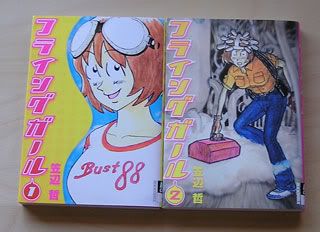
Flying Girl (フライングガール)
by Tetsu Kasabe (笠辺哲)
published in Ikki (Shogakukan)
2 volumes (2005-2006)
Amazon.jp
When Ikki was founded as a side publication of Big Comic Spirits in 2000, it was outfitted with a hefty lineup of critical and artistic favorites. With Taiyo Matsumoto (Ping Pong, Blue Spring), Naoki Yamamoto (Believers, Dance Till Tomorrow), Iou Kuroda (Nasu), Toyokazu Matsunaga (Bakune Young), Jiro Matsumoto, Kahori Onozuka and Yoko Nihonbashi, they attracted significant interest by loading up on big names. By necessity, as those artists finished their series -- one of the defining features of Ikki being its remarkable trust in its authors and total shunning of the popularity survey method of determining what to run -- some of them returned but others drifted off to other publications, and Ikki would be forced to develop its own new talent. Three artists in particular (Kazuo Hara [Noramimi], Hisae Iwaoka [Flower Cookies] and Tetsu Kasabe) have made Ikki their home for several books' worth of material, and with fairly similar styles combining a light fantastical touch with episodic content, represent what I consider to be the model of homegrown Ikki mangaka.
In Kasabe's case, he carved out his niche with a lengthy series of individual one-shots (six, in fact) over a span of 18 months, all of which were collected in the excellent Bunnies and Others, before starting on his first serial with Flying Girl. On paper, Flying Girl sounds like a cross between Urusei Yatsura's expand-and-conquer hijinx and Richie Rich's gadget-a-day utility. A completely boring, whitebread (or is that miso-and-rice?) government employee named Yamada is set to "Todd Duty" by his smirking boss -- Todd Duty being the supervision of eccentric genius inventor Professor Todd. Todd's inventions are superbly fascinating but often lacking in common sense or just plain dangerous, and it is these more questionable devices that Yamada is supposed to prevent the professor from creating in his mountainside retreat. Complicating matters is the beautiful and busty (her bust measurement in centimeters displayed on the very cover of the book) assistant Isogai, whom Yamada, being somewhat of a putz, immediately falls in love with. Ostensibly this infatuation and its potential realization are the ultimate goal of the story, but the clear star of the show are the inventions themselves.
Kasabe's creations exhibit the kind of dynamism necessary for this type of wacky, character-based comedy -- from the dopey yet stoic Yamada to the benevolent but aloof Professor, to the curious and rambunctious Isogai, as well as several others -- but it is the inventions themselves, many stemming from classic sci-fi archetypes, that act as the catalyst to bring about the humor. In one early chapter, Yamada attempts to slip Isogai the Professor's powerful new arousal drug, only to swallow it himself and share a passionate tryst with a goat, as the others look on and comment. In another, the Professor's "soul-switcher" exchanges the minds of Yamada and Isogai, then follows their mishaps in each other's bodies; Yamada finds that it's hard to run like a man when you have boobs and desperately avoids the temptation to feel himself up, while Isogai enacts her deep desire to pee off of a cliff. The gee-whiz inventions and their effects are nothing you couldn't imagine in the golden age of Tezuka and Leiji Matsumoto sci-fi manga, but Kasabe's addition to the formula is the giddy, anarchic lengths to which he pushes it.
In addition to multiple cases of the above-mentioned bestiality and sexual adventure, Flying Girl features a yakuza's severed, living head in a jar; his son, a "jungle boy" raised in the wild; a squat, bald mob boss who acts as the severed head's lover/caretaker and surrogate mother to the boy; as well as several talking animals - all the result of Professor Todd's inventions. Despite the level of chaos on parade, each installment generally ends with all wrongs righted, and the unruffled characters are willing to wryly comment on whatever disasters occur, such as one episode in which Yamada and the other characters are turned to stone for a year. When they are restored, he panics and calls his boss, expecting to be fired for a full year's absence, but the boss flippantly responds, "Oh, you're alive? Well, keep it up." This breezy nature is accentuated by Kasabe's rather plain, sketchy artwork, featuring simple, cartoonish portraits and humble, hand-drawn backgrounds, adding up to a light, quick read.
This formula of low-key cleverness is what distinguishes Kasabe and his compatriots Hara and Iwaoka from other artists and characterizes latter-day Ikki material. Flying Girl isn't exactly the kind of thing one would build a collection around, but it makes for excellent garnish.
4 comments:
This more or less confirms what I've seen in some of his scanlated one-shots.
Very light, goofy reading.
I had no idea at all he has a serial on his name, and I loved his shorts so much too.
Teneis que ver esta pagina: Fanatic Manga. Es flipante, tiene material muy bueno, imagenes, videos, series, etc...
Thank you so much for sharing all this wonderful info with the how-to's!!!! It is so appreciated!!! You always have good humor in your posts/blogs. So much fun and easy to read!
Lazy Nezumi Pro Crack
NTLite Crack
Farming Simulator Crack
Sparkocam Crack
Post a Comment